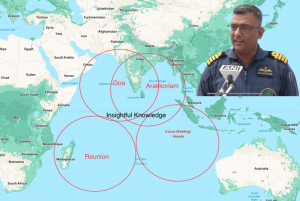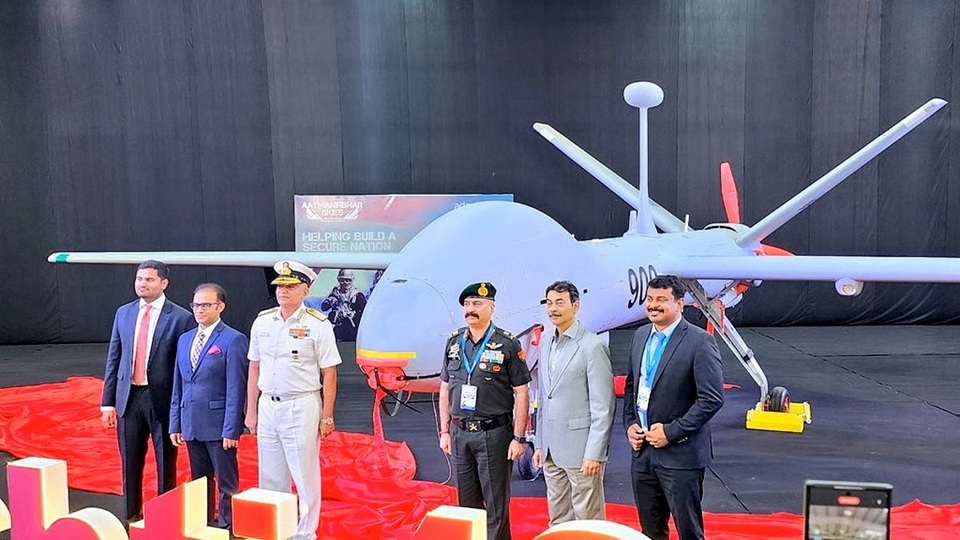In June 2017, residents of Sikkim saw a strange, grey-coloured aircraft loitering in that region for days together. On scrutiny, they found the Indian Navy written on its fuselage. What was an Indian Navy aircraft (P8I) doing in that part of India? The puzzle for them was more intriguing than the puzzle of ‘Seven Bridges of Königsberg’.
The puzzle remained unsolved until the then Chief of Defence Staff Gen Bipin Rawat disclosed in early 2020 that the Indian Army had utilized the services of the Indian Navy’s P8I Poseidon Long Range Maritime Patrol (LRMP) aircraft throughout the 73-day-long Doklam standoff with China. The P8I kept a tab on the Chinese troops and did live streaming of their movements. He further disclosed that a similar exercise was undertaken soon after the Pulwama terror attack to check the moment of the Pakistani forces.
Soon thereafter P8I became a permanent fixture in the Himalayas, helping the Indian Army against the People’s Liberation Army (PLA). Be it the Galwan Valley clash or a four-year-long line of actual control (LAC) standoff. The sole reason behind IN positioning its P8I in the Himalayas was that the Indian Air Force (IAF) lacked Intelligence, surveillance, target acquisition, and reconnaissance (ISTAR) capabilities.
What is ISTAR?
ISTAR (Intelligence, surveillance, target acquisition, and reconnaissance) is a special-purpose aircraft that has the capability of gathering intelligence and carrying out surveillance, target acquisition, and reconnaissance. The IAF has several airborne warning and control systems (AWACS) and airborne early warning and control (AEW&C) aircraft. However, these aircraft lack ISTAR capabilities.
The ISTAR-capable aircraft are equipped with multimode synthetic aperture radar (SAR) to track aerial and land-based targets. These aircraft are also capable of long-range oblique photography (LOROP) and high-speed data processing. Using a data link, the comprehensive battleground picture could be transmitted to the ground or aerial command post for further analysis and action.
During various border skirmishes and standoffs, it was felt that the IAF’s lack of ISTAR capabilities was affecting the commander’s decision-making capabilities. Though IAF embarked on the search for an ISTAR platform in 2013, the requirement remains unfulfilled. That is the reason that IAF issued a ₹6000 crore request for information (RFI) for three ISTAR platforms in May 2024.
The Reconnaissance Beast
To fulfil the IAF’s lack of ISTAR capabilities, the Indian Navy’s P8I Poseidon or Neptune was the right stopgap arrangement. With surveillance and reconnaissance, search and rescue, and long-range anti-submarine capabilities, the P-8 is the leading multi-mission aircraft in the world. It can take a to and fro journey of 1200 nautical miles and thereafter stay on the task for four hours. The lesser the distance more is the patrolling time.
The P-8I is based on a commercial Boeing 737 NG platform having 86% commonality. No wonder that more than 178 aircraft are in service across the world having clocked over 560,000 flight hours.
The Acquisition
At the turn of the century, the Indian Navy was feeling the need to replace the ageing LRMP fleet of Tu-142M and Il-38. Therefore, in 2008 Indian Navy took a decisive step in that direction. The American Boeing company proposed a customized P-8A for India, naming it P-8I. The proposal included Raytheon APY-10 multi-mission surface search radar, Telephonics APS-143 Ocean Eye radar for the Observers, and a CAE AN/ASQ-508A Magnetic Anomaly Detector (MAD) to track enemy submarines.
In 2009 India placed an order for eight P8-I aircraft and ground support equipment, worth $2.1 billion. The first aircraft was received at INAS 312, INS Rajali in May 2013. This order was followed up with another in 2016 for an additional four aircraft at the cost of $1 billion. The last of these four was delivered in December 2021 to INAS 316, INS Hansa.
While the Indian Navy flies the P-8I variant, the United States Navy, the Royal Australian Air Force, the UK’s Royal Air Force, Norway’s Royal Norwegian Air Force, and New Zealand’s Royal New Zealand Air Force fly the P-8A Poseidon variant. The US Navy with 130 P-8As is the biggest operator in the world, followed by the Indian Navy and the Royal Australian Air Force having 12 each.
The P-8I is designed to undertake various missions, namely — anti-submarine warfare (ASW), anti-surface warfare (ASUW), and intelligence, surveillance, and reconnaissance (ISR) roles. This last role of ISR was requisitioned and utilized by the Indian Army in the Himalayan standoff.
The original P-8I’s capabilities were further enhanced with the BEL Data Link II communication system to share tactical data between aircraft, ships, and shore-based command centres, the Avantel mobile satellite system, and Electronics Corporation of India’s (ECIL) speech secrecy system.
The internal weapons bay can carry Mark 54 All-Up-Round lightweight torpedoes, depth charges, and free-fall bombs. The under-wing hard points could be utilised to carry 226-kg blast/fragmentation warhead-equipped air-to-surface AGM-84L Harpoon Block II anti-ship and land target missiles.
The Equipment and the Armament
The countermeasures include the directional infrared countermeasures (DIRCM) system and the electronic support measures (ESM) system. The Boeing Company is very enthusiastic about expanding businesses in the Indo-Pacific region. That is amply clear from the present Boeing ecosystem in India with impressive numbers — 5000 employees, 300 suppliers, and an economic impact of $1.7 billion. With the arrival of an additional six P-8Is, this ecosystem would zoom to $3.2 billion.
The Future
The Indian Navy and the Defence Research and Development Organisation (DRDO) are also studying ways and means to integrate air-launched naval mines, the underdevelopment BrahMos-NG air-launched cruise missile, Miniature Air Launched Decoy, Naval Anti-Ship Missile – Medium Range (NASM-MR), Torpedo Advanced Light (TAL), and precision-guided bombs with P-8I.
In 2021, the US State Department cleared the sale of an additional six P-8Is to India. But this time it would be different. Since India and the US have signed the Communications Compatibility and Security Agreement (COMCASA) these aircraft would be fitted with encrypted communication systems. It means that this communication equipment would facilitate interoperability between all the militaries that use US-origin systems for secured data links.
It is noteworthy that the Indian Navy’s 12 P-8I (additional 6 cleared), 6 MH-60R multi-role helicopters (total 24 on order), and 15 MQ-9B UAVs (total 31 for all three services) with interoperability capability and COMCASA in place would be a force to reckon with in the Indian Ocean Region (IOR).
Imagine a war scenario where P-8I, MH-60R, and MQ-9B in a well-coordinated manner spread out to ranges beyond the Indian Navy fleet ships and submarines’ onboard sensors and jointly provide the ASW screen cover. This mighty fleet of airborne assets would protect the surface and subsurface fleet from surprise enemy attacks. P-8I will not only detect such targets but will classify and destroy them by using onboard torpedoes, depth charges, and missiles.
Today P-8I gets deployed and operates from the French La Réunion Island, Mauritian Agaléga Island, Australian Cocos (Keeling) Island, Japan’s Atsugi, American Guam Island, and many other undisclosed locations in addition to the Indian Navy’s bases. P-8I has also become a huge force multiplier in the ongoing operations in the Gulf of Aden and the Red Sea.

Captain AK Singh Ex CO INS 312 Explains the Reach of P-8I
Captain (IN) AK Singh, Ex-Commanding Officer, INAS 312 could very confidently say: “There is no possibility that any ship or submarine would be able to pass the Indian Ocean Region without the 312 Squadron coming to know about it.” There is no better person than Captain AK Singh, to sum up the capabilities of this mighty platform. INAS 312 alone has clocked over 40,000 hours on P-8I. No wonder some rightly call P-8I Poseidon an exemplary combination of ‘Brain and Muscle’.
Title Image Courtesy: Times of India
Disclaimer: The views and opinions expressed by the authors do not necessarily reflect the views of the Government of India and Defence Research and Studies
Article Courtesy: Chanakya Forum









